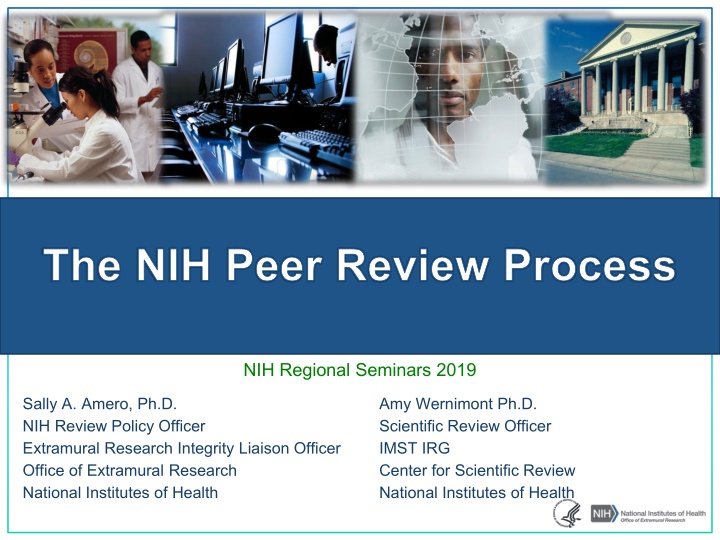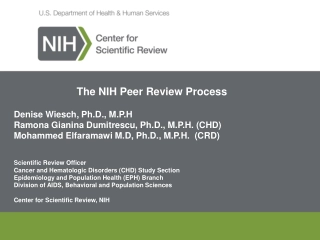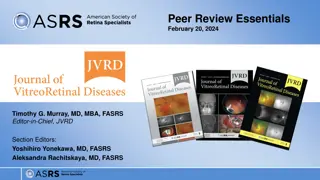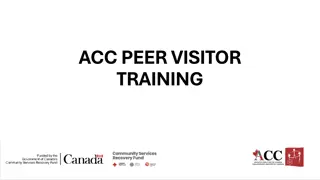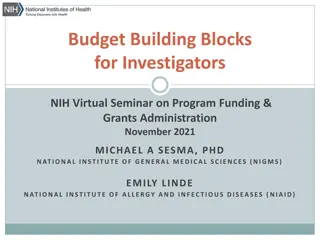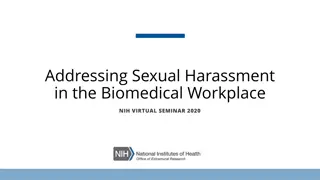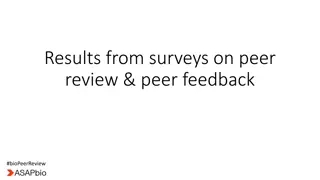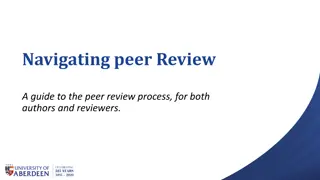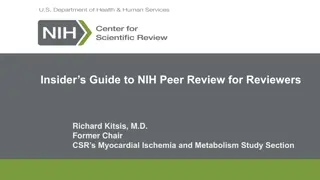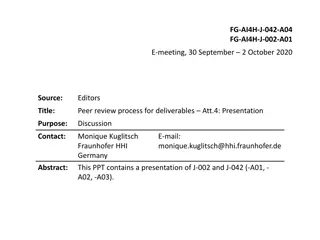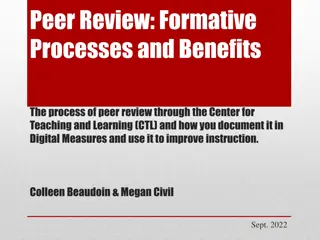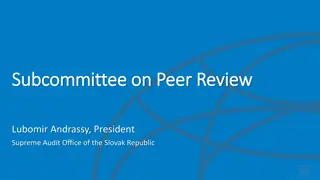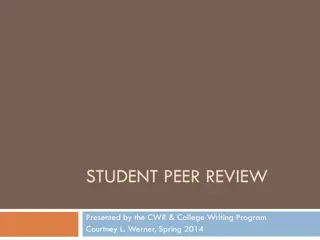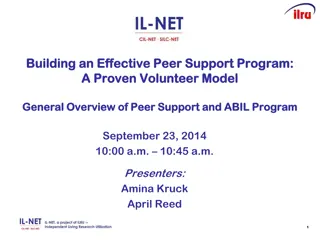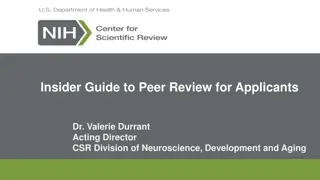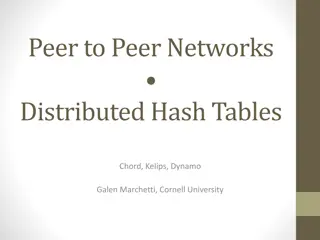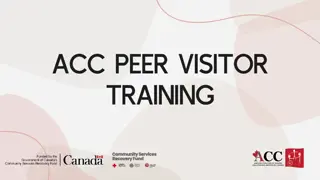The NIH Peer Review Process: Insights from NIH Experts
Delve into the intricate NIH peer review process with insights from Dr. Sally A. Amero and Dr. Amy Wernimont. Explore the two-stage review process, scope of initial peer review, key decisions by the Division of Receipt and Referral, and the diverse institutes under the National Institutes of Health. Gain a comprehensive understanding of how applications are reviewed and funded in the world of extramural research.
Download Presentation

Please find below an Image/Link to download the presentation.
The content on the website is provided AS IS for your information and personal use only. It may not be sold, licensed, or shared on other websites without obtaining consent from the author.If you encounter any issues during the download, it is possible that the publisher has removed the file from their server.
You are allowed to download the files provided on this website for personal or commercial use, subject to the condition that they are used lawfully. All files are the property of their respective owners.
The content on the website is provided AS IS for your information and personal use only. It may not be sold, licensed, or shared on other websites without obtaining consent from the author.
E N D
Presentation Transcript
The NIH Peer Review Process NIH Regional Seminars 2019 Sally A. Amero, Ph.D. NIH Review Policy Officer Extramural Research Integrity Liaison Officer Office of Extramural Research National Institutes of Health Amy Wernimont Ph.D. Scientific Review Officer IMST IRG Center for Scientific Review National Institutes of Health
NIH Peer Review Cornerstone of NIH extramural research Standard of excellence worldwide Two-stage review process National Advisory Council Review Receipt and Referral Funding decision Submit your application Initial Peer Review 2
Scope of NIH Initial Peer Review Use 26,000 reviewers/yr Fill 52,000 slots /yr 27,000 90,000 Applications reviewed Individual reviewers 80,000 26,000 70,000 25,000 60,000 24,000 50,000 40,000 23,000 30,000 22,000 20,000 21,000 10,000 20,000 0 2011 2013 2015 2017 Reviewers Total Apps R Apps NIH Data Book (https://report.nih.gov/nihdatabook/) 3 3
Division of Receipt and Referral (DRR) Key decisions Policy compliance (format, timeliness, etc.) Assignment to Institute(s) for funding consideration Assignment to study section for initial peer review Scientific Focus & Mission Relevance Program Officials (POs) Funding Institute(s) IC DRR Council Application Director Scientific Review Group Initial Review Groups (CSR or ICs) Scientific Review Officers (SROs) 4
National Institutes of Health Office of the Director National Institute of Arthritis and Musculoskeletal and Skin Diseases Eunice Kennedy Shriver National Institute of Child Health and Human Development National Institute on Alcohol Abuse and Alcoholism National Institute of Allergy and Infectious Diseases National Cancer Institute National Institute on Aging National Institute on Deafness and Other Communication Disorders National Institute of Dental and Craniofacial Research National Institute of Diabetes and Digestive and Kidney Diseases National Institute of Environmental Health Sciences National Institute on Drug Abuse National Eye Institute National Institute of Neurological Disorders and Stroke National Institute of General Medical Sciences National Heart, Lung, and Blood Institute National Human Genome Research Institute National Institute of Mental Health National Institute of Nursing Research National Institute of Biomedical Imaging and Bioengineering National Center for Complementary and Integrative Health National Institute on Minority Health and Health Disparities John E. Fogarty International Center National Center for Advancing Translational Sciences National Library of Medicine Center for Information Technology Center for Scientific Review Clinical Center 5
Submitting a Cover Letter The cover letter conveys important information: Application title FOA # and title Any special situations (such as a late application) Statement if proposed studies will generate large-scale genomic data or if a video will be submitted 6
PHS Assignment Request Form The PHS Assignment Request form conveys: Awarding component assignment requests Study section assignment requests Individuals who should not review your application and why Expertise needed to review the application Optional form in all NIH application form packages. 7
New PHS Assignment Request form 8
Requesting a Study Section Information about study sections: http://public.csr.nih.gov/StudySections/Pages/default.aspx Center for Scientific Review study sections http://public.csr.nih.gov/StudySections/Pages/default.aspx Assisted Referral Tool (ART) https://art.csr.nih.gov/ART/selection.jsp Rosters are available on NIH websites https://public.era.nih.gov/pubroster/ http://www.csr.nih.gov/Committees/rosterindex.asp eRA Like (A Thesaurus-based Search Tool) http://era.nih.gov/services_for_applicants/like_this/likethis.cfm Not all study section/IC requests can be honored. https://art.csr.nih.gov/ART/selection.jsp https://public.era.nih.gov/pubroster/ http://www.csr.nih.gov/Committees/rosterindex.asp http://era.nih.gov/services_for_applicants/like_this/likethis.cfm 9
Post-Submission Materials Submitted after the application, and must: Result from an unforeseen administrative event Conform to format policy and page limits Be submitted to the SRO 30 days before the review Demonstrate concurrence of Authorized Organization Representative Some Funding Opportunity Announcements may Specify other allowable materials Change the time window 10
Post-Submission Materials Among materials allowed (See NOT-OD-17-066) News of an article accepted for publication since submission of the application: List of authors and institutional affiliations Title of the article Journal or citation (if available) Citations of issued patents Videos - the only non-traditional materials allowed Follow a special process for videos See NOT-OD-12-141 Not allowed: Pre-prints, other Interim Research Products (See NOT-OD-17-050) 11
Maintaining Integrity in Peer Review All materials, discussions, and documents are confidential deleted or destroyed after review. All questions must be referred to the SRO. Reviewers: Do not contact applicants directly! Applicants: Do not contact reviewers directly! Research Misconduct Fabrication, falsification, or plagiarism. Reviewers: Report allegations directly to the SRO in confidence. 12
Level 1: Initial Peer Review Key decisions Scientific and technical merit of the work proposed Overall impact Appropriate justification for human subject protection, inclusion, and vertebrate animals Managed by Scientific Review Officers (SROs) Scientific Focus & Mission Relevance Program Officials (POs) Funding Institute(s) IC DRR Council Application Director Scientific Review Group Initial Review Groups (CSR or ICs) Scientific Review Officers (SROs) 13
Level 1: Initial Peer Review Reviewers How they are chosen Expectations for reviewers Review Policy Review criteria Scoring system What happens at the meeting? After the meeting Picture courtesy of the NIH Center for Scientific Review 14
Reviewers General Qualifications: Expertise Stature in field Mature judgment Impartiality Ability to work well in a group Managed conflicts of interest Balanced representation Availability Picture courtesy of the NIH Center for Scientific Review 15
Reviewer Recruitment Expertise of the reviewer Suggestions from the PI on expertise not names! Suggestions from Program staff and Study Section members Managing conflicts of interest Balancing workload 16
Managing Conflict of Interest Types of Conflict of Interest (COI) Financial - Professional associates Employment - Study Section membership Personal - Other interests Appearance of COI Depending on the COI, the reviewer with a COI must be: Excluded from serving on the Study Section, or Recused from discussion and scoring of a particular application. 17
Review Service NIH-funded investigators are expected to serve as reviewers when asked. NIH grantee institutions and contract recipients are expected to encourage their investigators to serve. See NOT-OD-15-035. 18
Reviewer Assignments For each application: Three qualified reviewers are assigned for in- depth assessment = assigned reviewers The SRO recruits reviewers and assigns applications Assignments are confidential! 19
What Reviewers Do Before the Meeting Examine assignments (~ six weeks in advance) May participate in an orientation teleconference Sign Conflict of Interest and Confidentiality certifications Read applications, prepare written critiques Enter preliminary scores, critiques into secure website Read and consider critiques and preliminary scores from other Study Section members 20
Written Critiques Five Scored Criteria Other Criteria Overall Impact 21
Review Criteria: Overall Impact Overall consideration for all NIH applications Defined differently for different types of applications Research grant applications: Likelihood for the project to exert a sustained, powerful influence on the research field(s) involved 22
Types of Review Criteria Criteria (Research) Criterion Scores? Yes Affect Overall Impact Score? Yes Category* Scored Review Criteria Significance Investigators Innovation Approach Environment Study Timeline (CT only) Human Subjects** Vertebrate Animals** Inclusion** Biohazards Foreign Institutions Select Agents Resource Sharing Authentication of Key Resources Additional Review Criteria No Yes Additional Review Considerations No No * Found in every Funding Opportunity Announcement ** If Unacceptable, award cannot be issued until resolved 23
Rigor and Transparency Four components (*Can affect the scores): Scientific premise for the proposed work* Scientific rigor of the work proposed* Consideration of relevant biological variables* Authentication of key biological/chemical resources Implemented for most: Research grant applications Mentored Career Development Award applications See Rigor and Reproducibility: http://grants.nih.gov/reproducibility/index.htm http://grants.nih.gov/reproducibility/index.htm 24
Clinical Trials NIH initiatives to enhance the accountability and transparency of clinical research And peer review: Clinical Trial-specific Funding Opportunities (FOAs) Clinical Trial-Specific Review Criteria Picture courtesy of the NIH Communications Office 25
NIH Scoring System Reviewers give numerical scores 1 (exceptional) to 9 (poor) Used for criterion scores and final impact score Score 1 2 3 4 5 6 7 8 9 Descriptor Exceptional Outstanding Excellent Very Good Good Satisfactory Fair Marginal Poor Impact High Impact Moderate Impact Low Impact 26
At the Review Meeting Any member in conflict with an application leaves the room. Reviewer 1 introduces the application and presents critique, including all score-able issues (scored criteria, human subjects protection, vertebrate animals, etc.). Reviewers 2 and 3 highlight additional issues and areas that significantly impact scores. Disagreements are discussed, clarified Picture courtesy of the NIH Center for Scientific Review 27
At the Review Meeting Continued Chair summarizes. Assigned reviewers provide final scores (setting range). All members provide final scores privately (if voting out of range, rationales are given). Non-score-able issues discussed: budget, data sharing plan, foreign applications, etc. Picture courtesy of the NIH Center for Scientific Review 28
Final Impact Scores Each member votes based on discussion Not just assigned reviewers Voted by private ballot at the meeting Final Impact Scores range from 10 through 90 Calculated by averaging all reviewers scores and multiplying by 10 Percentiled for some mechanisms 10 Highest Impact 90 Lowest Impact 29
Streamlining Applications Allows discussion of more meritorious applications Less meritorious applications Not discussed at the meeting Designated Not Discussed (ND) ND requires full concurrence of the entire study section ND Scored 30
After the Review eRA Commons https://public.uat.era.nih.gov/commons (https://public.uat.era.nih.gov/commons) Final Impact Score within 3 days Summary statement available within 4 8 weeks to: Funding Institute Program Officer PD/PI Other NIH Officials Advisory Council members 31
Summary Statement Summary statements contain: Reviewer critiques Criterion scores First page NIH Program Official (upper left corner) Final Impact Score or other designation Percentile (if applicable) Codes (human subjects, vertebrate animals, inclusion) Budget request A favorable score does not guarantee funding! 33
Summary Statement - continued Subsequent Pages Resum and Summary of Discussion (if discussed) Description (provided by applicant) Criterion scores from assigned reviewers Reviewer critiques essentially unedited Administrative Notes Meeting roster Picture courtesy of the NIH Center for Scientific Review 34
After the Review Meeting Your point of contact is the assigned NIH Program Official. You may need to: Submit Just-in-Time (JIT) information Resolve human subject, vertebrate animal, inclusion codes Consider your options: Submit a new application Revise and resubmit your application Appeal the review outcome (NOT-OD-11-064) 35
Level 2 of NIH Peer Review: Councils Key Decisions: Funding recommendations Program priority Scientific Focus & Mission Relevance Program Officials (POs) Funding Institute(s) IC DRR Council Application Director Scientific Review Group Initial Review Groups (CSR or ICs) Scientific Review Officers (SROs) 36
National Advisory Councils Broad and diverse membership Basic/research scientists Clinician scientists Public members Awards cannot be made without Council approval Council procedures vary across IC s Council is chaired by Institute Director, advised by IC extramural research staff 37
National Advisory Councils Advise IC Director about Research priority areas Diverse policy issues Concept clearance for future initiatives Funding priorities Recommend applications for funding Expedited awards En bloc concurrence Consider unresolved appeals and grievances related to initial peer review 38
Funding Decisions: IC Director The IC Director makes the final funding decisions Based on: Mission of the NIH Institute or Center Program priorities, Congressional mandates Outcome (score/percentile) of initial peer review Additional outside expertise, if needed Recommendation of IC Program Staff Recommendation of the IC Advisory Council Available Funds 39
New Considerations! Beginning with the January 25, 2019 due date: Revised review criterion language Scientific premise Inclusion across the lifespan New Parent Announcements Join the Guide Table of Contents (TOC)! http://grants.nih.gov/grants/guide/listserv.htm 40
NIH Live Mock Study Section! Today at 4:45 5:30 See typical scenarios from NIH study sections Ask questions of NIH staff Picture courtesy of the NIH Center for Scientific Review 41
Additional Information Office of Extramural Research Peer Review Process http://grants.nih.gov/grants/peer_review_process.htm Peer Review Policies & Practices http://grants.nih.gov/grants/peer/peer.htm Center for Scientific Review http://public.csr.nih.gov/Pages/default.aspx NIH Guide to Grants and Contracts http://grants.nih.gov/grants/guide/index.html NIH RePORTER Matchmaker https://projectreporter.nih.gov/reporter_matchmaker.cfm http://grants.nih.gov/grants/peer_review_process.htm http://grants.nih.gov/grants/peer/peer.htm http://public.csr.nih.gov/Pages/default.aspx http://grants.nih.gov/grants/guide/index.html https://projectreporter.nih.gov/reporter_matchmaker.cfm 42
